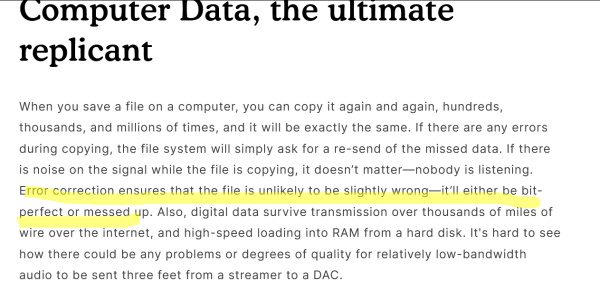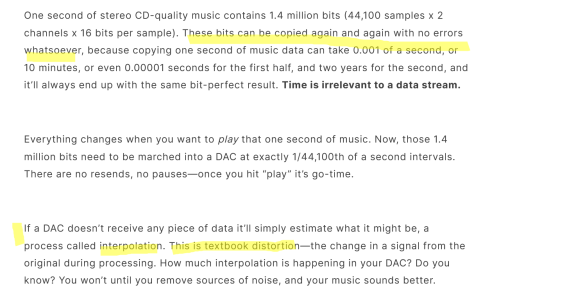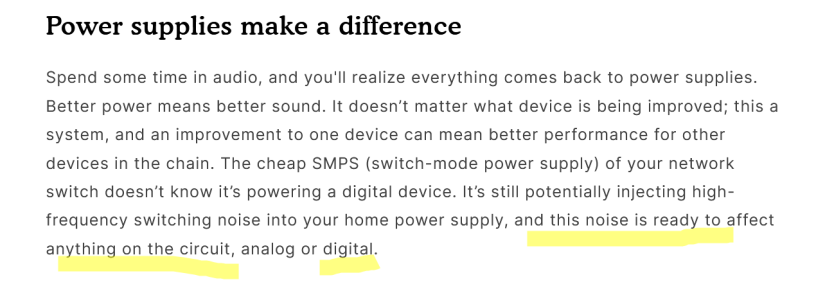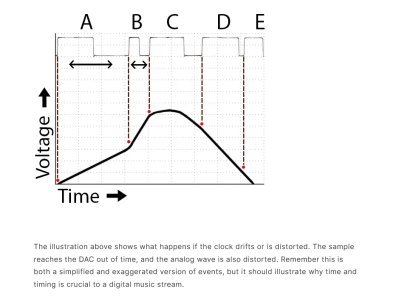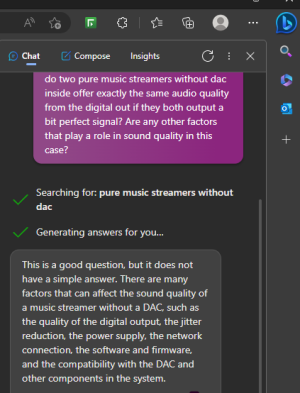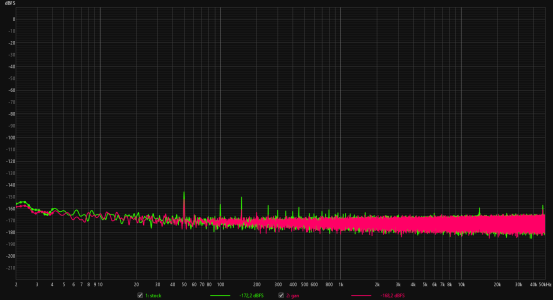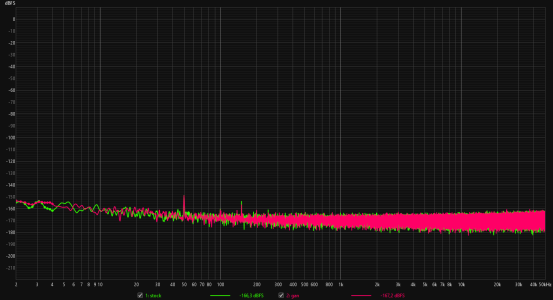Look at the reports how the charger is supposed to affect the digital output and ask yourself if we are talking about competent devices in the chain... If we are not considering an illusion of course.Hasn’t this old canard (pun intended) been gone over before ad nauseum - jitter doesn’t really matter on the WiiM’s digital outputs and even if it did, it’s more than handled by any competent external DAC?
You are using an out of date browser. It may not display this or other websites correctly.
You should upgrade or use an alternative browser.
You should upgrade or use an alternative browser.
Linear power supply
- Thread starter Mr.Wilson
- Start date
steadyshot
Major Contributor
- Joined
- Mar 14, 2023
- Messages
- 895
I agree that the charger can affect other devices indirectly .At least 3 cases for different chargers scenarios:
- charger affects the Mini and the result can be shown directly on the analog output for example
- charger affects the Mini and the result can be shown on the toslink output but measured through the receiver - so receiver's abilities to handle the incoming signal matters, like jitter suppression
- charger affects any other device in the audio chain through the Mini output
- charger affects any other device in the audio chain indirectly
Fourth case is unrelated to the Mini but it's related to the presence of low quality / outdated / vintage devices.
Third one can happen for the analog output when some issues like ground loop exist in the chain.
For the first case I've noticed a measurably significant difference only when the Mini was in idle state. No difference or insignificant one when it was playing anything.
Second case has been mentioned by me previously.
As for the dac . It is vague to say that a dac has jitter suppression . How much jitter can it suppress ? In what way does it do that ? Are there any “costs” incurred the harder it works to suppress jitter? Is the digital waveform 100% readable from the dac ? What affects the synchronization of the clock of the dac to the streamer?
Last edited:
I would suggest you to educate yourself when so many questions as you can find better answers than those ones I can provide. There are different incoming jitter suppression techniques, i.e. PLLs acting like low pass filter. A modern and properly designed DAC is able to remove incoming jitter enough to get a waveform bit-perfect to the source, in common scenarios like the one with Mini.
Last edited:
steadyshot
Major Contributor
- Joined
- Mar 14, 2023
- Messages
- 895
You suggestion to educate myself is welcome. However here is the opposition in summary : https://upscaleaudio.com/pages/bits-is-bits
steadyshot
Major Contributor
- Joined
- Mar 14, 2023
- Messages
- 895
The opposition covers also things you have supported in the past ,as for instance the example of hard drive in the thread about optical cables and the cable importance using again using the argument of bit perfect . But for now, as you can see from the partial screenshots, it states that interpolation - which is a form of error correction of the dac, is distortion. How will that be depicted on a graph? Would you able to discriminate or it will seem bit perfect? Again about jitter, if the dac will follow similar techniques to correct timing errors then it would be again a compromise, as it will again estimate the correct shape of waveform in order to interpret the correct order of 1s and 0s . It shows that error correction techniques have costs.
The source though is not the most credible but it raises some points that audiophile product manufacturers claim to be true.
So what is your background?
The source though is not the most credible but it raises some points that audiophile product manufacturers claim to be true.
So what is your background?
Attachments
Last edited:
A simple path:The opposition covers also things you have supported in the past ,as for instance the example of hard drive in the thread about optical cables and the cable importance using again using the argument of bit perfect . But for now, as you can see from the partial screenshots, it states that interpolation - which is a form of error correction of the dac, is distortion. How will that be depicted on a graph? Would you able to discriminate or it will seem bit perfect? Again about jitter, if the dac will follow similar techniques to correct timing errors then it would be again a compromise, as it will again estimate the correct shape of waveform in order to interpret the correct order of 1s and 0s . It shows that error correction techniques have costs.
raw uncompressed audio file > streamer > audio stream over toslink > receiver > audio stream over usb > PC > raw uncompressed audio file
When audio file at the beginning is bit equal to the audio file at the end, we have a bit-perfect audio chain. That includes a time factor. And that also means that the jitter has been rejected successfully to get "a perfectly re-created sine wave" in the digital domain. Again, it's the Mini scenario when connected to the properly designed DAC.
Regarding SMPS example - it's a feature of modern devices, especially with amplifier circuits, to have PSR ratio high enough to suppress power supply noise. That's why some devices can be sensitive to SMPSes - low quality / obsolete / outdated / vintage ones. And partially "audiophile" ones.
Last edited:
steadyshot
Major Contributor
- Joined
- Mar 14, 2023
- Messages
- 895
So you can copy and paste the waveforms input and output and they will 100% overlap, correct?So how many devices pass this test? I assume most... Therefore I am delusional and I hear voices. Ok I am out...A simple path:
raw uncompressed audio file > streamer > audio stream over toslink > receiver > audio stream over usb > PC > raw uncompressed audio file
When audio file at the beginning is bit equal to the audio file at the and, we have a bit-perfect audio chain. That includes a time factor. And that also means that the jitter has been rejected successfully to get "a perfectly re-created sine wave" in the digital domain. Again, it's the Mini scenario when connected to the properly designed DAC.
If you say so, bye bye.Therefore I am delusional and I hear voices. Ok I am out...
steadyshot
Major Contributor
- Joined
- Mar 14, 2023
- Messages
- 895
likyfrances@
New member
- Joined
- Jan 15, 2024
- Messages
- 1
Would WIIM mini or Pro benefit from a lineair power supply instead of a traditional power adapter. Would it improve the
There's no doubt that the sound has a big improve if you have a Linear power supply instead.Would WIIM mini or Pro benefit from a lineair power supply instead of a traditional power adapter. Would it improve the sound quality?
cc_rider
Major Contributor
- Joined
- Oct 20, 2022
- Messages
- 1,631
Actually, there’s plenty of doubt. I’ve not seen any objective evidence backing up this assertion.There's no doubt that the sound has a big improve if you have a Linear power supply instead.
So you've provided an example how people tend to believe what they "Wish" to be true.People tend to believe what they "Wish" to be true, a $200 streamer sound just as good as a $2000 one. How I wish that to be true and I could be saving a lot of money. I remember 40 years ago they said all amplifiers sound the same, and now "1s and 0s sounds the same" nothing could be further from the truth, the more "resolving" the system is, more different could be heard. You could not measure sound reacts to human hearing, just like you can't measure food reacts to your taste bugs.
Some people say that an LPS is always an improvement. Some people say that the difference is even bigger for higher quality equipment. Let's verify the second assumption for the noise level on the analog output when device is idle.
Mini vs Pro vs Pro Plus
Pro Plus charger vs the cleanest power source I can provide - linear regulated batteries
Mini:
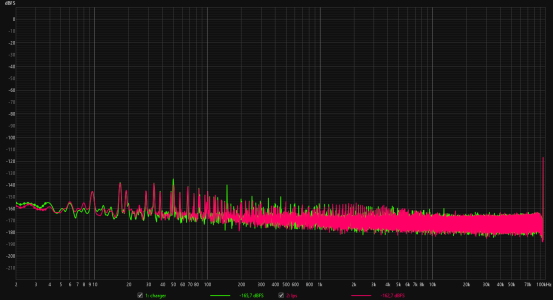
Whatever I use, results will be noisy.
Pro:
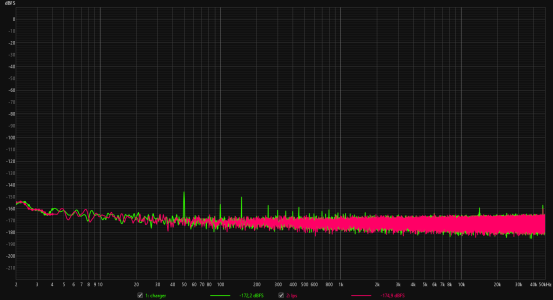
Visible differences, no noise for lps.
Pro Plus:
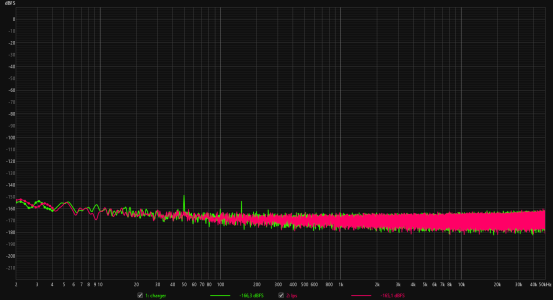
Visible differences again, no noise for lps again. But, the difference is smaller when compared to the Pro. Better device, better filtering on the analog output stage.
Mini vs Pro vs Pro Plus
Pro Plus charger vs the cleanest power source I can provide - linear regulated batteries
Mini:

Whatever I use, results will be noisy.
Pro:

Visible differences, no noise for lps.
Pro Plus:

Visible differences again, no noise for lps again. But, the difference is smaller when compared to the Pro. Better device, better filtering on the analog output stage.
So, can I say / ask what I *think* the graphs are telling me, and you can correct me?!Some people say that an LPS is always an improvement. Some people say that the difference is even bigger for higher quality equipment.
The regular power supply is a little noisier than the battery power supply, particularly around mains frequency (50 hz) and multiples of that?
The db numbers for both are way quieter than anything I'd ever hear?
The difference on the pro plus, being the 'higher quality' item here, is not bigger - i.e. a higher quality device is possibly actually less 'improved' by a LPS?
In fact the regular power supply is much much noisier itself. You can see above the impact of the power supply on the powered device. It's not about the noise of the power supply.The regular power supply is a little noisier than the battery power supply, particularly around mains frequency (50 hz) and multiples of that?
I would say so. But as it's about the noise for an idle device, you can hear it if you amplify the output hard enough.The db numbers for both are way quieter than anything I'd ever hear?
Yes.The difference on the pro plus, being the 'higher quality' item here, is not bigger - i.e. a higher quality device is possibly actually less 'improved' by a LPS?
steadyshot
Major Contributor
- Joined
- Mar 14, 2023
- Messages
- 895
I am using ifi ipower x and ifi lan silencer with wiim pro plus. The favorites of @onlyoneme 
Yeah, I really love their color and the designI am using ifi ipower x and ifi lan silencer with wiim pro plus. The favorites of @onlyoneme
Similar threads
- Replies
- 1
- Views
- 243
- Suggestion
- Replies
- 6
- Views
- 572
- Question
- Replies
- 7
- Views
- 527
- Replies
- 0
- Views
- 268

